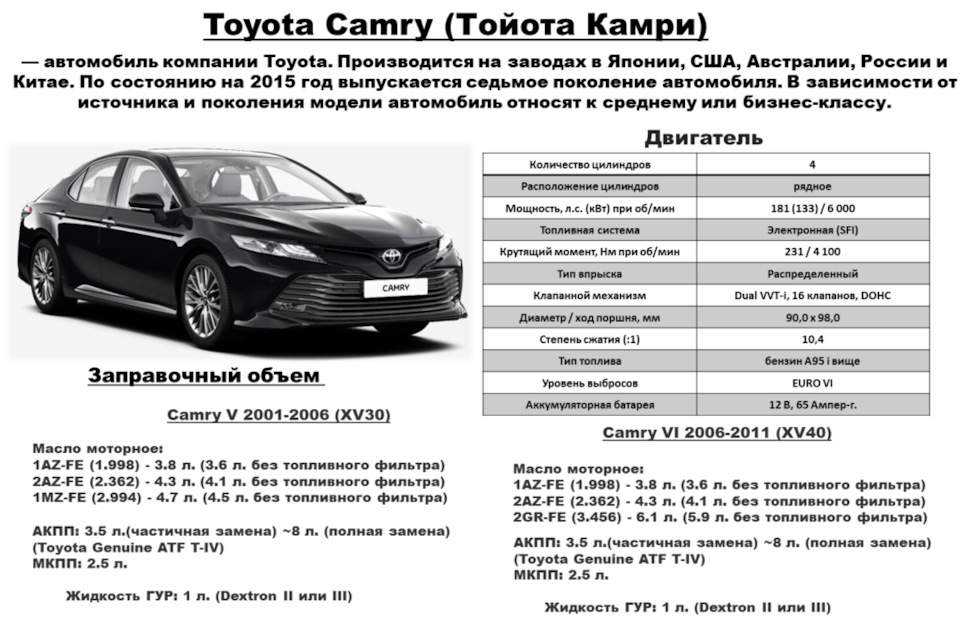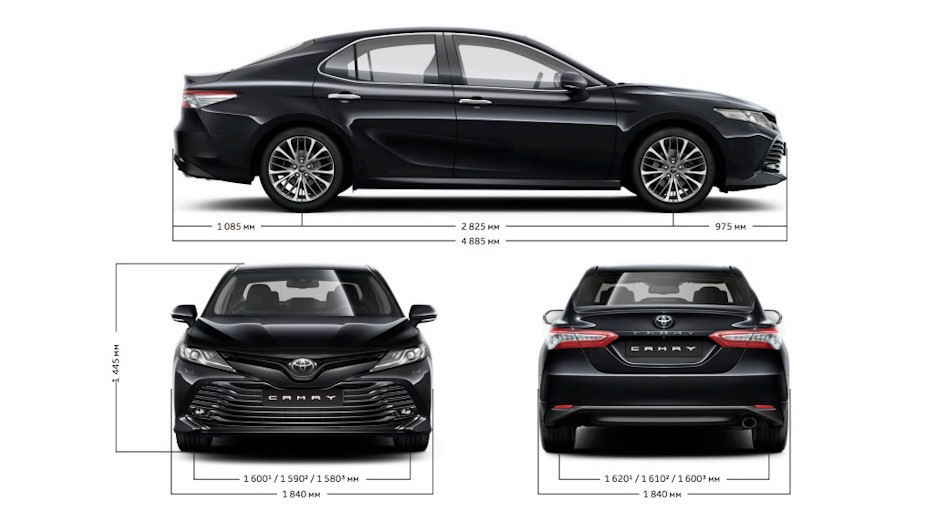- Manuals
- Brands
- Toyota Manuals
- Toy
- Camry 2020
- Quick reference manual
-
Contents
-
Table of Contents
-
Bookmarks
Quick Links
QUICK
REFERENCE
GUIDE
2020
Related Manuals for Toyota Camry 2020
Summary of Contents for Toyota Camry 2020
-
Page 1
QUICK REFERENCE GUIDE 2020… -
Page 2
Owner’s Manual. Each box contains safe operating instructions to help you avoid injury or equipment malfunction. All information in this Quick Reference Guide is current at the time of printing. Toyota reserves the right to make changes at any time without notice. -
Page 3
Seat heaters/ventilators BLUETOOTH® DEVICE Seats-Head restraints 46-48 PAIRING SECTION Visit your Toyota dealer for information on customizing this feature. Programmable by customer. Refer to the Owner’s Manual for instructions and more information. ® HomeLink is a registered trademark of Gentex Corporation. -
Page 4: Instrument Panel
OVERVIEW Instrument panel Dynamic Radar Cruise Control (DRCC) vehicle-to-vehicle distance Meter control switches Paddle shifters button Dynamic Radar Cruise Control (DRCC) or Cruise control switch Audio volume Audio remote control control switch switches Steering wheel controls Voice command switch Lane Departure Alert with Steering Telephone switch Assist (LDA w/SA) switch Meters/Multi-Information Display (MID)
-
Page 5
If equipped. For details, refer to the “Navigation and Multimedia System Owner’s Manual” or visit www.toyota.com/audio-multimedia for additional resources. Emergency flasher switch Audio/navigation system Air conditioning/heating controls Seat heaters /ventilators switches Qi Wireless charger switch Electric parking brake switch Driving mode select switches… -
Page 6: Instrument Cluster
OVERVIEW Instrument cluster Outside temperature 4.2-inch display Odometer/trip meter Shift position Tachometer Speedometer Multi-information display Engine coolant temperature display Fuel gauge Instrument panel light control 7-inch display Multi-information display Tachometer Speedometer Odometer/trip meter Shift position Fuel gauge Outside temperature Instrument panel light control Engine coolant temperature display Service indicators and reminders Indicator symbols…
-
Page 7
If the indicator does not turn off within a few seconds of starting the engine, there may be a malfunction. Have the vehicle inspected by your Toyota dealer. If the indicator flashes, there may be a malfunction. Refer to the Owner’s Manual. -
Page 8: Locking Operation
OVERVIEW Keyless (and remote) entry UNLOCKING OPERATION Smart Key Carry Smart Key remote Driver door unlock* Grasp Push ONCE: Driver door TWICE: All doors NOTE: If a door is not opened within 60 seconds of unlocking, all doors will relock for safety. * Driver door unlocking function can be programmed to unlock driver door only, or all doors.
-
Page 9: Smart Key System
Smart key system START FUNCTION Carry remote Depress to start brake pedal Push NOTE: The Smart Key must be carried to enable the start function. With the gear shift lever in Park and the brake pedal depressed, push the “ENGINE START STOP”…
-
Page 10: Hood Release
OVERVIEW Hood release Pull Pull up latch and raise hood Engine maintenance Engine oil filler cap Engine oil level dipstick Windshield washer fluid tank Engine coolant reservoir Engine oil level dipstick Engine oil filler cap Windshield washer fluid tank Engine coolant reservoir NOTE: Regularly scheduled maintenance, including oil changes, will help extend the life of your vehicle and maintain performance.
-
Page 11: Features & Operations
FEATURES & OPERATIONS Automatic transmission Shift lever + (“S” mode) Park* Reverse — (“S” mode) Neutral Paddle shifters* Drive + (“S” mode) — (“S” mode) “S” mode *If equipped Shift the shift lever to “S” position from “D” position. Downshifting increases power going uphill, or provides engine braking downhill. For best fuel economy during normal driving conditions, always drive with the shift lever in the “D”…
-
Page 12: Parking Brake
FEATURES & OPERATIONS Steering lock release Smart Key Without Smart Key Turn Turn Turn Push When starting the engine, the engine A message informing the driver that the switch may seem stuck in the “LOCK” steering wheel is locked will be position.
-
Page 13
Electric parking brake (if equipped) PARKING BRAKE Driver side Automatic mode Manual mode Parking brake light Parking brake light Automatic (shift lever operation) To turn automatic mode ON, while vehicle is stopped, pull and hold switch until While depressing brake, shifting into P position will automatically set the brake and turn the parking brake indicator and parking brake light on. -
Page 14
FEATURES & OPERATIONS Driving mode select switches (if equipped) Normal — Suitable for normal driving. SPORT mode — Use when a higher level of response is desired, such as when driving in mountainous regions. ECO MODE — Helps achieve lower fuel consumption during trips that involve frequent accelerating and braking. -
Page 15: Seat Adjustments-Front
Seat adjustments — Front Seatback angle Seat position (forward/backward) Height crank (driver side only) Seat position (forward/backward) Seatback angle Lumbar support (if equipped, driver side only) Seat cushion angle Height crank (driver side only) Seat folding — Rear (if equipped) Pull Fold down Tip: To fold rear seats, the release button is located in the trunk.
-
Page 16: Lights & Turn Signals
Automatically switches between high and low Automatic High Beam (AHB) system beams as appropriate to enhance vision at night. Refer to Toyota Safety Sense P (TSS-P) in this guide or the Owner’s Manual for ™ more details on the Automatic High Beam feature.
-
Page 17: Windshield Wipers And Washers
Windshield wipers & washers Mist Adjust frequency* Interval wipe Slow Pull to wash and wipe Fast Rotate to increase/decrease * Intermittent windshield wiper frequency adjustment wipe frequency. Refer to the Owner’s Manual for more details. Seat heaters/ventilators (if equipped) Without seat ventilators With seat ventilators Front passenger Front passenger…
-
Page 18: Air Conditioning/Heating
FEATURES & OPERATIONS Air conditioning/heating Without “SYNC” button Airflow mode display Temperature selector Fan speed Air Conditioning ON/OFF Automatic climate control ON — Adjusting the temperature setting will cause the airflow vents, air intake and fan to adjust automatically to set Rear window defogger temperature.
-
Page 19
With “SYNC” button (continued) “SYNC” button — Indicator ON: Synchronized temperature settings for driver and pas- Type B sengers. Indicator OFF: Separate temperature settings for driver and passengers. Temperature selector Temperature selector (passenger’s side) Airflow mode display (driver’s side) Outside rearview mirror*/ Windshield airflow/defogger rear window defogger Automatic climate control ON -… -
Page 20
FEATURES & OPERATIONS Blind Spot Monitor with Rear Cross Traffic Alert (BSM w/RCTA) (if equipped) Outside rear view mirror indicators Indicators Buzzer (RCTA only) RCTA function display Indicators The Blind Spot Monitor is a system that has two functions: The system is designed to use radar sensors to detect vehicles traveling in the Camry’s blind spot. -
Page 21: Rear View Monitor System
Rear view monitor system The rear view monitor system displays an image of the view from the bumper of the rear area of the vehicle. The camera for the rear view monitor system is located above the license plate. To adjust the image on the rear view monitor screen, press the “MENU” button and select “Display”…
-
Page 22
FEATURES & OPERATIONS Multi-Information Display (MID) Indicators Shift position Menu icons Display area Previous screen Odometer/trip meter control Enter/Select display Scroll/search Indicators screens Odometer/trip meter control Push “meter control switches” to change information in the following: Drive information Warning messages Audio system-linked display Settings display Driving assist system information… -
Page 23
Color Head-up display (HUD) (if equipped) Shift position/speed limit display area Driving assist system status/ navigation system-linked display area Vehicle speed display (if equipped) Information display area ECO driving indicator/Tachometer The head-up display can display the current vehicle speed and ECO driving indicator in front of the driver. -
Page 24: Tilting Operation
FEATURES & OPERATIONS Panoramic glass roof with front moonroof (if equipped) SLIDING OPERATION Open and closing the electronic sunshade Open — Slide and hold the switch backward. The electronic sunshade will open fully automatically.* Close — Slide and hold the switch forward.
-
Page 25
Moonroof (if equipped) SLIDING OPERATION TILTING OPERATION Push once to open partway; Push once to open completely. again to open completely. Open Tilt Close Close Recommended driving position to minimize wind noise. Lightly press either side of the moonroof switch while opening/tilting is in progress, the moonroof stops partway. -
Page 26: Door Locks
FEATURES & OPERATIONS Door locks Lock Unlock Bottle holders/Cup holders Front Rear CUP HOLDERS Front Rear (if equipped)
-
Page 27
Power outlet-12V DC USB media port Open lid Connecting a compatible device and cable into the USB media port will support charging and music playback through the audio multimedia system. USB charge-ports (if equipped) (Charge only) -
Page 28
Refer to the “Navigation and Multimedia System Owner’s Manual” or visit www.toyota.com/audio-multimedia for additional resources. NOTE: Concentrating on the road should always be your first priority while driving. Do not use the Audio Multimedia System if it will distract you. -
Page 29: Steering Wheel Switches
Steering wheel switches (Audio, MID & phone: Bluetooth ® Audio switches “MODE” Push to change audio mode. Push and hold to mute or pause the audio. Volume controls Seek Phone switches Receive/end call Voice command switch Microphone ® Bluetooth technology allows dialing or receipt of calls without removing your hands from the steering wheel.
-
Page 30
FEATURES & OPERATIONS Qi Wireless charger (if equipped) Operation indicator light Charge area Power switch Press (1) When the engine is turned off, the last state (ON/ OFF) of the charger is memorized. Place (2) Place device nearest the center of charging area for best results. -
Page 31: Garage Door Opener
Clock Select to change time zone Select to daylight savings time ON/OFF/AUTO Select to set to automatic GPS adjustment of clock. Select to set hour display to 12 or 24 hour time. MENU” button next to the screen. Setup” or “General” in the touch screen to access the general settings screen.
-
Page 32: Toyota Safety Sense
™ TOYOTA SAFETY SENSE Quick overview-Toyota Safety Sense™ P (TSS-P) ™ Toyota Safety Sense to help mitigate or prevent collisions across a wide range of traffic situations, in certain conditions. TSS-P is designed to help support the driver’s awareness, decision making and vehicle operation contributing to a safe driving experience.
-
Page 33
Refer to the Toyota Owner’s Manual for a list of additional situations in which the system may not operate properly. Pre-Collision Warning… -
Page 34
As part of the Pre-Collision System, this function is also designed to first provide an alert and then automatic braking if needed. Refer to the Toyota Owner’s Manual for additional limitations and information. CHANGING PCS ALERT TIMING Middle… -
Page 35
Note: The system is enabled each time the power switch is turned to ON mode. Refer to the Toyota Owner’s Manual for additional information on PCS operation, settings adjustments, limitations, and precautions before attempting to use it. Lane Departure Alert with Steering Assist… -
Page 36
Ignition cycle until changed by the driver or the system is reset. Refer to the Toyota Owner’s Manual for additional information on LDA operation, settings adjustments, limitations, and precautions before attempting to use it. LANE DEPARTURE ALERT… -
Page 37
For example, LDA may not function on the side(s) where white/yellow lines are not detectable. Refer to the Toyota Owner’s Manual for additional information on LDA operation, settings adjustments, limitations, and precautions before attempting to use it. -
Page 38
™ TOYOTA SAFETY SENSE SWAY WARNING SYSTEM Continuous lane deviations from swaying. Gentle swaying from driver’s inattentiveness. Acute steering wheel operation after the number of operations decrease due to driver’s inattentiveness. SWS is a function of LDA and is designed to detect swaying based on the vehicle location in the lane and the driver’s steering wheel operation. -
Page 39
Dynamic Radar Cruise Control (DRCC) or Full-Speed Range* DRCC DRCC helps maintain a pre-set distance to a preceding vehicle when the preceding vehicle is traveling at a lower speed. This mode is always selected first when the cruise control button is depressed. Constant speed cruise control mode is also available. DRCC is designed to function at speeds between approximately 30 to 110 MPH and is intended for highway use. -
Page 40
™ TOYOTA SAFETY SENSE ADJUSTING DISTANCE Preceding To change the vehicle-to- vehicle mark vehicle distance Push the “ ” button to cycle through the settings, which will change progressively. LONG MIDDLE SHORT (default setting) This mode employs a radar sensor to detect the presence of a preceding vehicle following distance and operates to maintain a preset following distance from the vehicle ahead. -
Page 41
Decrease speed To adjust speed or cancel, see steps (2) and (3) of ADJUSTING SET SPEED on page 37. Refer to the Toyota Owner’s Manual for additional information on DRCC operation, settings adjustments, limitations, and precautions before attempting to use it. -
Page 42
By using high beams more frequently, the system may allow earlier detection of pedestrians and obstacles. Refer to the Toyota Owner’s Manual for additional information on AHB operation, settings adjustments, limitations, and precautions before attempting to use it. ACTIVATING THE AHB SYSTEM “AUTO”… -
Page 43: Seat Belts
SAFETY & EMERGENCY FEATURES Rear door child safety locks Rear door Unlock Lock Moving the lever downward will allow the door to be opened only from the outside. Seat belts Take up slack Too high Keep as low on hips as possible the Automatic Locking Retractor (ALR) will prevent it from being re-extended beyond that point, unless fully retracted again.
-
Page 44: Safety Connect
Safety Connect is a subscription-based telematics service that uses Global and security features to subscribers. Safety Connect is staffed with live agents at the Toyota response center, which operates 24 hours per day, 7 days per week. Services for subscribers include: •…
-
Page 45: Tool Location
Spare tire & tools TOOL LOCATION Luggage floor cover Jack handle Wheel nut wrench Jack Spare tire REMOVING THE SPARE TIRE (2) Loosen the center fastener that (1) Remove the tool tray. secures the spare tire. Refer to the Owner’s Manual for tire changing and jack positioning procedures. Trunk-Internal release Pull up…
-
Page 46
Your vehicle comes standard with the Star Safety System , which combines Anti- Toyota’s ABS sensors detect which wheels are locking up and limits wheel lockup by “pulsing” each wheel’s brakes independently. Pulsing releases brake pressure repeatedly for fractions of a second. This helps the tires attain the traction that current road conditions will allow, helping you to stay in directional control. -
Page 47: Floor Mat Installation
Traction Control helps maintain traction on loose gravel and wet, icy, or uneven Toyota’s TRAC sensors are activated when one of the drive wheels starts to slip. TRAC limits engine output and applies the brakes to the spinning wheel. This transfers power to the wheels that still have traction to help keep you on track.
-
Page 48
® BLUETOOTH DEVICE PAIRING SECTION ® Do not attempt the Bluetooth Pairing process while driving. -
Page 49
Pairing for your phone ® Pairing your phone is the first step in connecting with your Toyota. This pairing process is quick and easy. All you have to do is setup the phone and multimedia system to form a connection. -
Page 50
BLUETOOTH ® DEVICE PAIRING Bluetooth Pairing for your phone (cont.) ® «Connecting» displays while STEP 6 STEP 7 device is forming the connection to your multimedia system. phone a message will be «You may need to allow message access on your phone». -
Page 52
Quick Reference Guide 2020 toyota.com Printed in U.S.A. 9/19 19-MKG-13590…
Keys to Quality Maintenance
Toyota Owner manuals and warranty information are the keys to quality maintenance for your vehicle. No need to hunt down a separate Toyota repair manual or Toyota service manual. From warranties on Toyota replacement parts to details on features, Toyota Owners manuals help you find everything you need to know about your vehicle, all in one place.
Detailed Toyota manuals and Toyota warranty information help with questions about your vehicle specifications and maintenance schedules. Plus, learn more about what your Toyota warranty coverage includes. What’s more, Toyota warranty information helps you identify your unique vehicle needs as well as plan future service visits. Select your Toyota model to learn more about the Toyota Warranty for your car, truck or SUV. Or, get the Toyota Manual for your Toyota ride free of charge using our Toyota Owners manual free download option.
Read More
Read Less
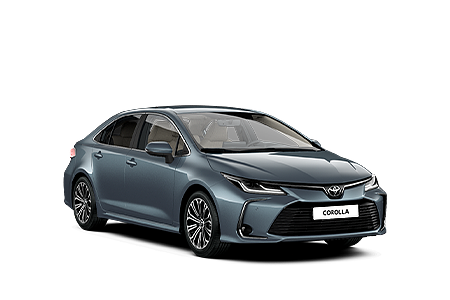
Corolla
Руководство для владельца
Руководство по эксплуатации навигационной и мультимедийной системы
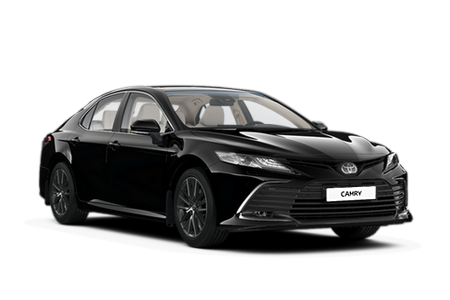
Camry
Руководство для владельца
Руководство по эксплуатации навигационной и мультимедийной системы
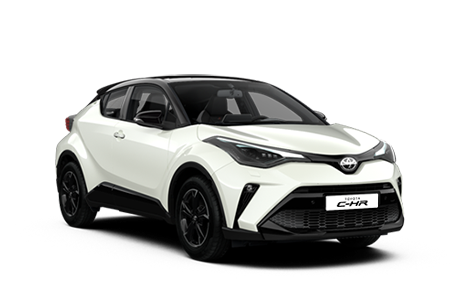
C-HR
Руководство для владельца
Руководство по эксплуатации навигационной и мультимедийной системы
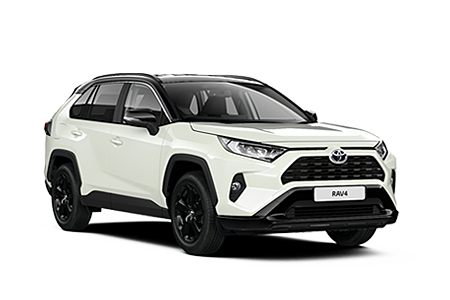
RAV4
Руководство для владельца
Руководство по эксплуатации навигационной и мультимедийной системы
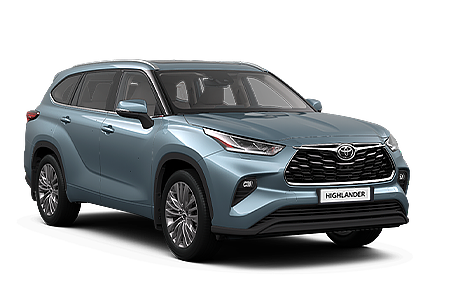
Highlander
Руководство для владельца
Руководство по эксплуатации навигационной и мультимедийной системы
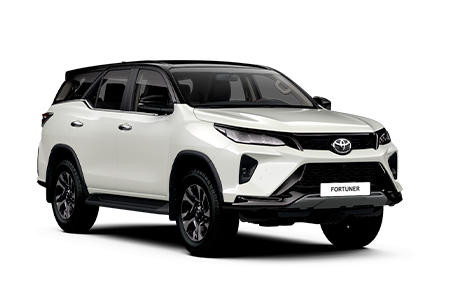
Fortuner
Руководство для владельца
Руководство по эксплуатации навигационной и мультимедийной системы
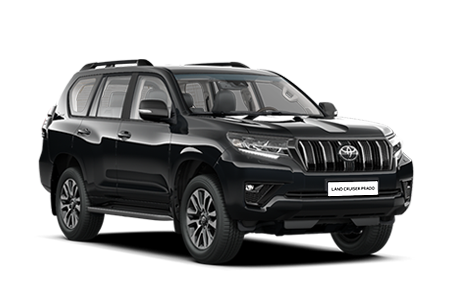
Land Cruiser Prado
Руководство для владельца
Руководство по эксплуатации навигационной и мультимедийной системы
Руководство по вождению в условиях бездорожья
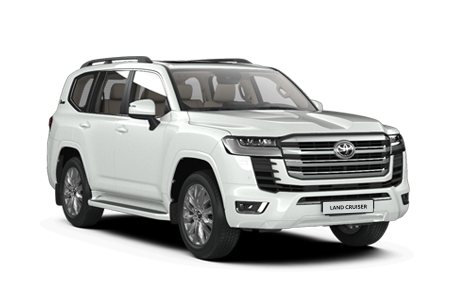
Land Cruiser 300
Руководство для владельца
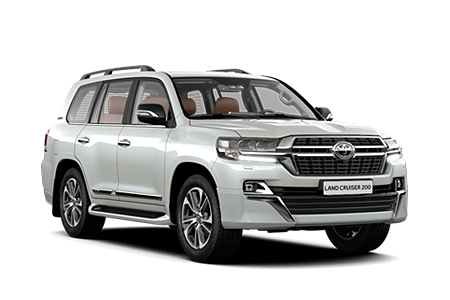
Руководство для владельца
Руководство по эксплуатации навигационной и мультимедийной системы
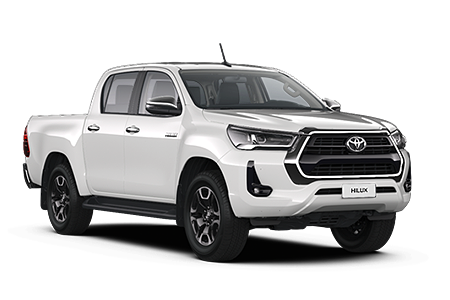
Hilux
Руководство для владельца
Руководство по эксплуатации навигационной и мультимедийной системы

Alphard
Руководство для владельца
Руководство по эксплуатации навигационной и мультимедийной системы
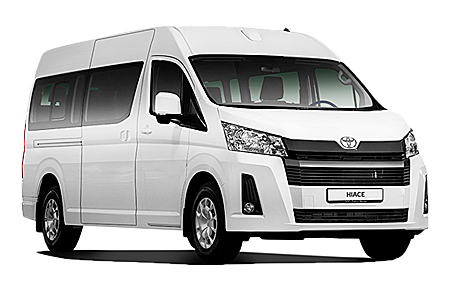
Hiace
Руководство для владельца
Руководство по эксплуатации навигационной и мультимедийной системы
Смотрите также:
Всем салют! Для удобства и быстрого доступа, создаю себе небольшой каталог электронных версий. Может и кому-то из вас пригодиться.
Электронная версия мануала — то что нашел в приложении MyT Toyota.
Руководство для владельца Toyota Camry XV70.
Ссылка на Англоязычную версию Руководство пользователя — любезно предоставленную Temeke
Руководство по эксплуатации навигационной и мультимедийной системы на платформе Android Toyota Camry XV70.
Руководство по ремонту и обслуживанию Camry xv70
Ремонт кузова и геометрия — взято у OKGV
Ссылка на инструкции для других моделей Toyota
Для всех машин Toyota можно посмотреть мануал ЗДЕСЬ.
Форум Toyota Camry — ЗДЕСЬ.


For safety 1 and security
Instrument 2 cluster
Operation of
3each component
4 Driving
5 Interior features
Maintenance 6 and care
When trouble 7 arises
Vehicle
8 specifications
9For owners
Index
Search by illustration
Make sure to read through them
How to read the gauges and meters, the variety of warning lights and indicators, etc.
Opening and closing the doors and windows, adjustment before driving, etc.
Operations and advice which are necessary for driving
Usage of the interior features, etc.
Caring for your vehicle and maintenance procedures
What to do in case of malfunction or emergency
Vehicle specifications, customizable features, etc.
Reporting safety defects for U.S. owners, and seat belt and SRS airbag instructions for Canadian owners
Search by symptom
Search alphabetically
CAMRY_U

2TABLE OF CONTENTS
|
For your information………………….. |
8 |
||
|
Reading this manual……………….. |
12 |
||
|
How to search………………………… |
13 |
||
|
Pictorial index ………………………… |
14 |
||
|
1 |
For safety and security |
||
|
1-1. For safe use |
|||
|
Before driving…………………. |
24 |
||
|
For safe driving ………………. |
26 |
||
|
Seat belts ………………………. |
28 |
||
|
SRS airbags…………………… |
34 |
||
|
Front passenger occupant |
|||
|
classification system ……… |
47 |
||
|
Exhaust gas precautions….. |
52 |
||
|
1-2. |
Child safety |
||
|
Riding with children…………. |
53 |
||
|
Child restraint systems…….. |
54 |
||
|
1-3. |
Emergency assistance |
||
|
Safety Connect……………….. |
73 |
||
|
1-4. Theft deterrent system |
|||
|
Engine immobilizer |
|||
|
system…………………………. |
79 |
||
|
Alarm…………………………….. |
82 |
|
2 |
Instrument cluster |
|
|
2. |
Instrument cluster |
|
|
Warning lights and |
||
|
indicators……………………… |
86 |
|
|
Gauges and meters…………. |
92 |
|
|
Multi-information display |
||
|
(4.2-inch display)…………… |
95 |
|
|
Multi-information display |
||
|
(7-inch display)……………. |
107 |
|
|
Head-up display…………….. |
121 |
|
|
Fuel consumption |
||
|
information………………….. |
127 |
CAMRY_U

3
|
3 |
Operation of each |
||
|
component |
|||
|
3-1. |
Key information |
||
|
Keys ……………………………. |
132 |
||
|
3-2. Opening, closing and |
|||
|
locking the doors |
|||
|
Doors…………………………… |
141 |
||
|
Trunk…………………………… |
149 |
||
|
Smart key system………….. |
154 |
||
|
3-3. Adjusting the seats |
|||
|
Front seats …………………… |
163 |
||
|
Rear seats |
|||
|
(folding type) ………………. |
165 |
||
|
Head restraints……………… |
167 |
||
|
3-4. Adjusting the steering |
|||
|
wheel and mirrors |
|||
|
Steering wheel ……………… |
169 |
||
|
Inside rear view mirror……. |
171 |
||
|
Outside rear view |
|||
|
mirrors……………………….. |
173 |
||
|
3-5. Opening and closing |
|||
|
the windows |
|||
|
Power windows …………….. |
175 |
||
|
Moon roof…………………….. |
179 |
||
|
Panoramic moon roof…….. |
183 |
|
4 |
Driving |
||
|
4-1. |
Before driving |
||
|
Driving the vehicle …………. |
190 |
||
|
Cargo and luggage………… |
198 |
||
|
Vehicle load limits………….. |
201 |
||
|
Trailer towing………………… |
202 |
||
|
Dinghy towing……………….. |
203 |
||
|
4-2. |
Driving procedures |
||
|
Engine (ignition) switch |
|||
|
(vehicles without a |
|||
|
smart key system) ……….. |
204 |
||
|
Engine (ignition) switch |
|||
|
(vehicles with a smart |
|||
|
key system) ………………… |
206 |
||
|
Automatic transmission ….. |
212 |
||
|
Turn signal lever……………. |
218 |
||
|
Parking brake ……………….. |
219 |
||
|
Electric parking brake…….. |
220 |
||
|
Brake Hold……………………. |
224 |
||
|
4-3. Operating the lights |
|||
|
and wipers |
|||
|
Headlight switch ……………. |
226 |
||
|
Automatic High Beam…….. |
230 |
||
|
Windshield wipers and |
|||
|
washer……………………….. |
234 |
||
|
4-4. |
Refueling |
||
|
Opening the fuel tank |
|||
|
cap…………………………….. |
238 |
CAMRY_U

4TABLE OF CONTENTS
|
4-5. Using the driving |
|
|
support systems |
|
|
Toyota Safety Sense P ….. |
242 |
|
PCS |
|
|
(Pre-Collision System) …. |
248 |
|
LDA |
|
|
(Lane Departure Alert |
|
|
with steering control)……. |
259 |
|
Dynamic radar cruise |
|
|
control with full-speed |
|
|
range…………………………. |
269 |
|
Dynamic radar cruise |
|
|
control ……………………….. |
283 |
|
Cruise control……………….. |
297 |
|
Driving assist systems……. |
302 |
|
BSM |
|
|
(Blind Spot Monitor) …….. |
308 |
|
• BSM function ……………. |
312 |
|
• RCTA function ………….. |
314 |
|
Rear Camera Detection |
|
|
Function …………………….. |
318 |
|
Intuitive parking assist……. |
322 |
|
Intelligent Clearance Sonar |
|
|
(ICS)………………………….. |
330 |
|
Driving mode select |
|
|
switches …………………….. |
351 |
|
4-6. Driving tips |
|
|
Winter driving tips………….. |
353 |
5 Interior features
5-1. Using the air conditioning system and defogger
|
Manual air conditioning |
|
|
system……………………….. |
358 |
|
Automatic air conditioning |
|
|
system (without “SYNC” |
|
|
button) ……………………….. |
363 |
|
Automatic air conditioning |
|
|
system (with “SYNC” |
|
|
button) ……………………….. |
369 |
|
Seat heaters/ |
|
|
seat ventilators ……………. |
377 |
5-2. Using the interior lights
|
Interior lights list…………….. |
379 |
|
• Interior lights……………… |
380 |
|
• Personal lights…………… |
381 |
|
5-3. Using the storage |
|
|
features |
|
|
List of storage features…… |
383 |
|
• Glove box…………………. |
384 |
|
• Console box ……………… |
384 |
|
• Coin holder……………….. |
384 |
|
• Bottle holders ……………. |
385 |
|
• Cup holders………………. |
386 |
|
• Auxiliary boxes………….. |
387 |
|
• Open tray …………………. |
388 |
|
Trunk features ………………. |
389 |
CAMRY_U

5
|
5-4. Other interior features |
|
|
Other interior features ……. |
390 |
|
• Sun visors ………………… |
390 |
|
• Vanity mirrors……………. |
390 |
|
• Power outlet……………… |
391 |
|
• USB charging ports……. |
392 |
|
• Wireless charger……….. |
394 |
|
• Armrest ……………………. |
403 |
|
• Assist grips ………………. |
403 |
|
• Coat hooks……………….. |
404 |
|
Garage door opener………. |
405 |
|
6 |
Maintenance and care |
||||
|
6-1. Maintenance and care |
|||||
|
Cleaning and protecting |
1 |
||||
|
the vehicle exterior ………. |
414 |
||||
|
Cleaning and protecting |
|||||
|
the vehicle interior |
417 |
||||
|
2 |
|||||
|
6-2. |
Maintenance |
||||
|
Maintenance |
|||||
|
requirements |
420 |
||||
|
3 |
|||||
|
General maintenance …….. |
423 |
||||
|
Emission inspection and |
|||||
|
maintenance (I/M) |
|||||
|
programs ……………………. |
427 |
4 |
|||
|
6-3. Do-it-yourself |
|||||
|
maintenance |
|||||
|
5 |
|||||
|
Do-it-yourself service |
|||||
|
precautions…………………. |
428 |
||||
|
…………………………….Hood |
430 |
||||
|
Positioning a floor jack……. |
431 |
6 |
|||
|
Engine compartment ……… |
432 |
||||
|
Tires |
444 |
||||
|
7 |
|||||
|
Tire inflation pressure…….. |
459 |
||||
|
Wheels…………………………. |
462 |
||||
|
Air conditioning filter |
464 |
||||
|
8 |
|||||
|
Wireless remote control/ |
|||||
|
electronic key battery …… |
466 |
||||
|
Checking and replacing |
|||||
|
fuses………………………….. |
470 |
9 |
|||
|
Light bulbs ……………………. |
473 |
||||
CAMRY_U

6TABLE OF CONTENTS
|
7 |
When trouble arises |
||
|
7-1. |
Essential information |
||
|
Emergency flashers ………. |
486 |
||
|
If your vehicle has |
|||
|
to be stopped in |
|||
|
an emergency …………….. |
487 |
||
|
If the vehicle is trapped |
|||
|
in rising water……………… |
489 |
||
|
7-2. Steps to take in |
|||
|
an emergency |
|||
|
If your vehicle needs |
|||
|
to be towed ………………… |
490 |
||
|
If you think something |
|||
|
is wrong……………………… |
493 |
||
|
Fuel pump shut off |
|||
|
system……………………….. |
494 |
||
|
If a warning light turns |
|||
|
on or a warning buzzer |
|||
|
sounds ………………………. |
495 |
||
|
If a warning message |
|||
|
is displayed ………………… |
505 |
||
|
If you have a flat tire………. |
510 |
||
|
If the engine will not |
|||
|
start…………………………… |
521 |
||
|
If the electronic key does |
|||
|
not operate properly |
|||
|
(vehicles with a smart |
|||
|
key system)………………… |
523 |
||
|
If the vehicle battery |
|||
|
is discharged………………. |
526 |
||
|
If your vehicle |
|||
|
overheats …………………… |
531 |
||
|
If the vehicle becomes |
|||
|
stuck………………………….. |
534 |
8 Vehicle specifications
|
8-1. Specifications |
|
|
Maintenance data |
|
|
(fuel, oil level, etc.) ………. |
538 |
|
Fuel information…………….. |
549 |
|
Tire information……………… |
552 |
|
8-2. |
Customization |
||
|
Customizable features……. |
565 |
||
|
8-3. Items to initialize |
|||
|
Items to initialize……………. |
573 |
||
|
9 |
For owners |
||
|
Reporting safety defects for |
|||
|
U.S. owners ……………………….. |
576 |
||
|
Seat belt instructions for |
|||
|
Canadian owners |
|||
|
(in French)………………………….. |
577 |
||
|
SRS airbag instructions for |
|||
|
Canadian owners |
|||
|
(in French)………………………….. |
578 |
CAMRY_U

7
|
Index |
|
|
What to do if… |
|
|
(Troubleshooting) ……………….. |
590 |
|
Alphabetical index…………………. |
594 |
For information regarding the equipment listed below, refer to “NAVIGATION AND MULTIMEDIA SYSTEM OWNER’S MANUAL”.
|
• Navigation system |
• Toyota parking assist monitor |
|
• Audio system |
• Panoramic view monitor |
|
• Rear view monitor system |
• Connected services |
CAMRY_U

8
For your information

Please note that this manual applies to all models and explains all equipment, including options. Therefore, you may find some explanations for equipment not installed on your vehicle.
All specifications provided in this manual are current at the time of printing. However, because of the Toyota policy of continual product improvement, we reserve the right to make changes at any time without notice.
Depending on specifications, the vehicle shown in the illustrations may differ from your vehicle in terms of equipment.

Approximately five hours after the engine is turned off, you may hear sound coming from under the vehicle for several minutes. This is the sound of a fuel evaporation leakage check and, it does not indicate a malfunction.

A wide variety of non-genuine spare parts and accessories for Toyota vehicles are currently available in the market. You should know that Toyota does not warrant these products and is not responsible for their performance, repair, or replacement, or for any damage they may cause to, or adverse effect they may have on, your Toyota vehicle.
This vehicle should not be modified with non-genuine Toyota products. Modification with non-genuine Toyota products could affect its performance, safety or durability, and may even violate governmental regulations. In addition, damage or performance problems resulting from the modification may not be covered under warranty.

The installation of a mobile two-way radio system in your vehicle could affect electronic systems such as:
●Multiport fuel injection system/sequential multiport fuel injection system
●Toyota Safety Sense P (if equipped)
●Cruise control system (if equipped)
●Anti-lock brake system
●SRS airbag system
●Seat belt pretensioner system
Be sure to check with your Toyota dealer for precautionary measures or special instructions regarding installation of a mobile two-way radio system.
CAMRY_U

9

The vehicle is equipped with sophisticated computers that will record certain data, such as:
The recorded data varies according to the vehicle grade level and options with which it is equipped.
These computers do not record conversations or sounds, and only record images outside of the vehicle in certain situations.
•Engine speed/Electric motor speed (traction motor speed)
•Accelerator status
•Brake status
•Vehicle speed
•Operation status of the driving assist systems, such as the ABS and precollision system
•Images from the camera (available only when certain safety systems are activated, which varies depending on the vehicle specifications).
●Data Transmission
Your vehicle may transmit the data recorded in these computers to Toyota without notification to you.
● Data usage
Toyota may use the data recorded in this computer to diagnose malfunctions, conduct research and development, and improve quality.
Toyota will not disclose the recorded data to a third party except:
•With the consent of the vehicle owner or with the consent of the lessee if the vehicle is leased
•In response to an official request by the police, a court of law or a government agency
•For use by Toyota in a lawsuit
•For research purposes where the data is not tied to a specific vehicle or vehicle owner
●Recorded image information can be erased by your Toyota dealer.
The image recording function can be disabled. However, if the function is disabled, data from when the pre-collision system operates will not be available.
●To learn more about the vehicle data collected, used and shared by Toyota, please visit www.toyota.com/privacyvts/.
Usage of data collected through Safety Connect (U.S. mainland only)
If your Toyota has Safety Connect and if you have subscribed to those services, please refer to the Safety Connect Telematics Subscription Service Agreement for information on data collected and its usage.
To learn more about the vehicle data collected, used and shared by Toyota, please visit www.toyota.com/privacyvts/.
CAMRY_U

10

This vehicle is equipped with an event data recorder (EDR). The main purpose of an EDR is to record, in certain crash or near crash-like situations, such as an air bag deployment or hitting a road obstacle, data that will assist in understanding how a vehicle’s systems performed. The EDR is designed to record data related to vehicle dynamics and safety systems for a short period of time, typically 30 seconds or less.
The EDR in this vehicle is designed to record such data as:
•How various systems in your vehicle were operating;
•Whether or not the driver and passenger safety belts were buckled/fastened;
•How far (if at all) the driver was depressing the accelerator and/or brake pedal; and,
•How fast the vehicle was traveling.
These data can help provide a better understanding of the circumstances in which crashes and injuries occur.
NOTE: EDR data are recorded by your vehicle only if a non-trivial crash situation occurs; no data are recorded by the EDR under normal driving conditions and no personal data (e.g., name, gender, age, and crash location) are recorded. However, other parties, such as law enforcement, could combine the EDR data with the type of personally identifying data routinely acquired during a crash investigation.
To read data recorded by an EDR, special equipment is required, and access to the vehicle or the EDR is needed. In addition to the vehicle manufacturer, other parties, such as law enforcement, that have the special equipment, can read the information if they have access to the vehicle or the EDR.
● Disclosure of the EDR data
Toyota will not disclose the data recorded in an EDR to a third party except when:
•An agreement from the vehicle’s owner (or the lessee for a leased vehicle) is obtained
•In response to an official request by the police, a court of law or a government agency
•For use by Toyota in a lawsuit
However, if necessary, Toyota may:
•Use the data for research on vehicle safety performance
•Disclose the data to a third party for research purposes without disclosing information about the specific vehicle or vehicle owner
CAMRY_U

11

The SRS airbag and seat belt pretensioner devices in your Toyota contain explosive chemicals. If the vehicle is scrapped with the airbags and seat belt pretensioners left as they are, this may cause an accident such as fire. Be sure to have the systems of the SRS airbag and seat belt pretensioner removed and disposed of by a qualified service shop or by your Toyota dealer before you scrap your vehicle.

Special handling may apply, See www.dtsc.ca.gov/hazardouswaste/perchlorate.
Your vehicle has components that may contain perchlorate. These components may include airbag, seat belt pretensioners, and wireless remote control batteries.

■General precautions while driving
Driving under the influence: Never drive your vehicle when under the influence of alcohol or drugs that have impaired your ability to operate your vehicle. Alcohol and certain drugs delay reaction time, impair judgment and reduce coordination, which could lead to an accident that could result in death or serious injury.
Defensive driving: Always drive defensively. Anticipate mistakes that other drivers or pedestrians might make and be ready to avoid accidents.
Driver distraction: Always give your full attention to driving. Anything that distracts the driver, such as adjusting controls, talking on a cellular phone or reading can result in a collision with resulting death or serious injury to you, your occupants or others.
■General precaution regarding children’s safety
Never leave children unattended in the vehicle, and never allow children to have or use the key.
Children may be able to start the vehicle or shift the vehicle into neutral. There is also a danger that children may injure themselves by playing with the windows, the moon roof or panoramic moon roof, or other features of the vehicle. In addition, heat build-up or extremely cold temperatures inside the vehicle can be fatal to children.
CAMRY_U

12
Reading this manual
WARNING:
Explains something that, if not obeyed, could cause death or serious injury to people.
NOTICE:
Explains something that, if not obeyed, could cause damage to or a malfunction in the vehicle or its equipment.
|
1 |
2 |
3 |
Indicates operating or working procedures. Follow the steps |
|
in numerical order. |
Indicates the action (pushing, turning, etc.) used to operate switches and other devices.
Indicates the outcome of an operation (e.g. a lid opens).
Indicates the component or position being explained.
Means “Do not”, “Do not do this”, or “Do not let this happen”.
CAMRY_U

13
How to search
|
■ Searching by name |
|
|
• Alphabetical index……. |
P. 594 |
|
■ Searching by |
installation |
||||||||||
|
position |
|||||||||||
|
• Pictorial index……………. |
P. 14 |
||||||||||
■ Searching by symptom or sound
• What to do if…
(Troubleshooting)……..P. 590
|
■ Searching by title |
|
|
• Table of contents…………. |
P. 2 |
CAMRY_U

Pictorial index
■Exterior
*2
*3
1 Doors . . . . . . . . . . . . . . . . . . . . . . . . . . . . . . . . . . . . . . . . . . . P. 141
Locking/unlocking . . . . . . . . . . . . . . . . . . . . . . . . . . . . . . . . . . P. 141 Opening/closing the door windows . . . . . . . . . . . . . . . . . . . . . P. 175 Locking/unlocking by using the mechanical key*1. . . . . . . . . . P. 523
2 Trunk. . . . . . . . . . . . . . . . . . . . . . . . . . . . . . . . . . . . . . . . . . . . P. 149
Opening from inside. . . . . . . . . . . . . . . . . . . . . . . . . . . . . . . . . P. 149 Opening from outside . . . . . . . . . . . . . . . . . . . . . . . . . . . . . . . P. 149
3 Outside rear view mirrors . . . . . . . . . . . . . . . . . . . . . . . . . . . P. 173
Adjusting the mirror angle . . . . . . . . . . . . . . . . . . . . . . . . . . . . P. 173 Folding the mirrors. . . . . . . . . . . . . . . . . . . . . . . . . . . . . . . . . . P. 173 Defogging the mirrors*1. . . . . . . . . . . . . . . . . . . . . . P. 359, 365, 372
CAMRY_U

4 Windshield wipers . . . . . . . . . . . . . . . . . . . . . . . . . . . . . . . . . P. 234
Precautions for winter season . . . . . . . . . . . . . . . . . . . . . . . . . P. 353
5 Fuel filler door . . . . . . . . . . . . . . . . . . . . . . . . . . . . . . . . . . . . P. 238
Refueling method. . . . . . . . . . . . . . . . . . . . . . . . . . . . . . . . . . . P. 238 Fuel type/fuel tank capacity . . . . . . . . . . . . . . . . . . . . . . . . . . . P. 540
6 Tires . . . . . . . . . . . . . . . . . . . . . . . . . . . . . . . . . . . . . . . . . .P. 444
Tire size/inflation pressure . . . . . . . . . . . . . . . . . . . . . . . . .P. 545 Winter tires/tire chains . . . . . . . . . . . . . . . . . . . . . . . . . . . .P. 353 Checking/rotation/tire pressure warning system . . . . . . . . .P. 444 Coping with flat tires . . . . . . . . . . . . . . . . . . . . . . . . . . . . . .P. 510
7 Hood . . . . . . . . . . . . . . . . . . . . . . . . . . . . . . . . . . . . . . . . . . . . P. 430
Opening . . . . . . . . . . . . . . . . . . . . . . . . . . . . . . . . . . . . . . . . . . P. 430 Engine oil. . . . . . . . . . . . . . . . . . . . . . . . . . . . . . . . . . . . . . . . . P. 541 Coping with overheat. . . . . . . . . . . . . . . . . . . . . . . . . . . . . . . . P. 531
Light bulbs of the exterior lights for driving
(Replacing method: P. 473, Watts: P. 548)
8 Front turn signal lights/
parking lights/daytime running lights*2 . . . . . . . . . . . . . . . P. 226 9 Headlights/daytime running lights*3 . . . . . . . . . . . . . . . . . . P. 226
10 Front side marker lights . . . . . . . . . . . . . . . . . . . . . . . . . . . . P. 226 11 Side turn signal lights*1 . . . . . . . . . . . . . . . . . . . . . . . . . . . . P. 226
12 Rear turn signal lights/rear side marker lights/
tail lights/stoplights. . . . . . . . . . . . . . . . . . . . . . . . . . . . P. 218, 226
13 Tail lights*1. . . . . . . . . . . . . . . . . . . . . . . . . . . . . . . . . . . . . . . P. 226
Back-up lights
Shifting the shift lever to R. . . . . . . . . . . . . . . . . . . . . . . . . . . . P. 212
14 License plate lights . . . . . . . . . . . . . . . . . . . . . . . . . . . . . . . . P. 226
*1: If equipped *2: Vehicles with LED type front side marker lights *3: Vehicles with bulb type front side marker lights
CAMRY_U

■Instrument panel
1 Engine switch. . . . . . . . . . . . . . . . . . . . . . . . . . . . . . . . . P. 204, 206
Starting the engine/changing the positions or modes . . . P. 204, 206 Emergency stop of the engine. . . . . . . . . . . . . . . . . . . . . . . . . P. 487 When the engine will not start . . . . . . . . . . . . . . . . . . . . . . . . . P. 521
2 Shift lever . . . . . . . . . . . . . . . . . . . . . . . . . . . . . . . . . . . . . . . . P. 212
Changing the shift position . . . . . . . . . . . . . . . . . . . . . . . . . . . P. 212 Precautions for towing . . . . . . . . . . . . . . . . . . . . . . . . . . . . . . . P. 490 When the shift lever does not move . . . . . . . . . . . . . . . . . . . . P. 216
3 Meters . . . . . . . . . . . . . . . . . . . . . . . . . . . . . . . . . . . . . . . . . . . . P. 92
Reading the meters/adjusting the instrument panel lights. . . . . P. 92 Warning lights/indicator lights . . . . . . . . . . . . . . . . . . . . . . . . . . P. 86 When a warning light comes on. . . . . . . . . . . . . . . . . . . . . . . . P. 495
Multi-information display . . . . . . . . . . . . . . . . . . . . . . . . P. 95, 107
Display. . . . . . . . . . . . . . . . . . . . . . . . . . . . . . . . . . . . . . . . P. 95, 107 When the warning messages are displayed . . . . . . . . . . . . . . P. 505
CAMRY_U

|
4 Parking brake. . . . . . . . . . . . . . . . . . . . . . . . . . . . . |
. . . . P. 219, 220 |
|
|
Applying/releasing . . . . . . . . . . . . . . . . . . . . . . . . . . |
P. 219, 220, 221 |
|
|
Precautions for winter season . . . . . . . . . . . . . . . . . . |
. . . . . . . P. |
354 |
|
Warning light/warning buzzer/ |
||
|
warning message. . . . . . . . . . . . . . . . . . . . . . . . . . . |
P. 219, 223, |
495 |
|
5 |
Turn signal lever . . . . . . . . . . . . . . . . . . . . . . . . . . |
. . . . . . . . P. 218 |
|
Headlight switch . . . . . . . . . . . . . . . . . . . . . . . . . . . |
. . . . . . . P. 226 |
|
|
Headlights/side marker lights/parking lights/tail lights/ |
||
|
license plate lights/daytime running lights . . . . . . . . . |
. . . . . . . P. 226 |
|
|
6 |
Windshield wiper and washer switch . . . . . . . . . . |
. . . . . . . P. 234 |
|
Usage . . . . . . . . . . . . . . . . . . . . . . . . . . . . . . . . . . . . |
. . . . . . . P. 234 |
|
|
Adding washer fluid . . . . . . . . . . . . . . . . . . . . . . . . . . |
. . . . . . . P. 443 |
|
|
7 |
Emergency flasher switch . . . . . . . . . . . . . . . . . . . |
. . . . . . . P. 486 |
|
8 |
Hood lock release lever. . . . . . . . . . . . . . . . . . . . . . |
. . . . . . . P. 430 |
|
9 |
Tilt and telescopic steering lock release lever . . . |
. . . . . . . P. 169 |
|
10 |
Air conditioning system . . . . . . . . . . . . . . . . . . . . |
P. 358, 363, 369 |
|
Usage . . . . . . . . . . . . . . . . . . . . . . . . . . . . . . . . . . . |
P. 358, 363, 369 |
|
|
Rear window defogger. . . . . . . . . . . . . . . . . . . . . . . |
P. 359, 365, 372 |
11Audio*1, 2 Audio Plus*1, 2
Premium Audio*1, 2 Clock*2
*1: If equipped *2: Refer to “NAVIGATION AND MULTIMEDIA SYSTEM OWNER’S MANUAL”.
CAMRY_U
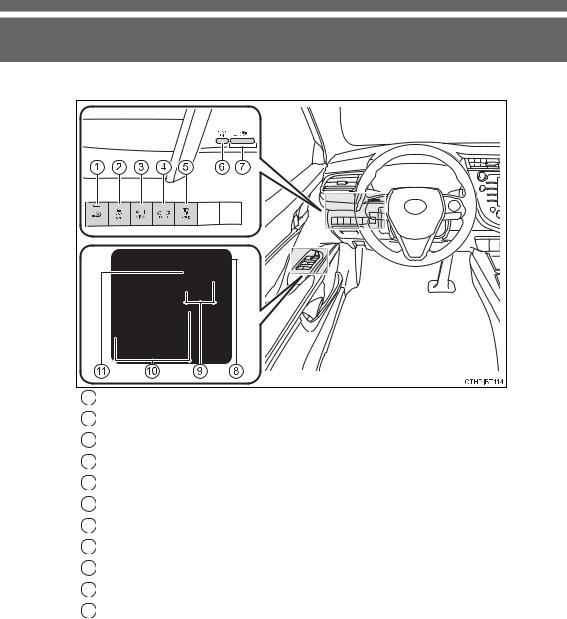
■Switches
|
1 |
Automatic High Beam switch*1 . . . . . . . . . . . . . . . . . . . . . . P. 230 |
|
2 |
VSC OFF switch. . . . . . . . . . . . . . . . . . . . . . . . . . . . . . . . . . . P. 303 |
|
3 |
Camera switch*1, 2 |
|
4 |
Trunk opener switch . . . . . . . . . . . . . . . . . . . . . . . . . . . . . . . P. 149 |
|
5 |
Fuel filler door opener switch. . . . . . . . . . . . . . . . . . . . . . . . P. 240 |
|
6 |
“ODO/TRIP” switch . . . . . . . . . . . . . . . . . . . . . . . . . . . . . P. 96, 109 |
|
7 |
Instrument panel light control switch . . . . . . . . . . . . . . . . . . P. 93 |
|
8 |
Outside rear view mirror switch. . . . . . . . . . . . . . . . . . . . . . P. 173 |
|
9 |
Door lock switches . . . . . . . . . . . . . . . . . . . . . . . . . . . . . . . . P. 145 |
|
10 |
Power window switches . . . . . . . . . . . . . . . . . . . . . . . . . . . . P. 175 |
|
11 |
Window lock switch. . . . . . . . . . . . . . . . . . . . . . . . . . . . . . . . P. 175 |
CAMRY_U

|
Pictorial index |
19 |
|||||||||||||||||||
|
1 |
Meter control switches . . . . . . . . . . . . . . . . . . . . . . . . . |
. P. 96, 108 |
|
2 |
Paddle shift switches*1. . . . . . . . . . . . . . . . . . . . . . . . . |
. . . . P. 212 |
|
3 |
Vehicle-to-vehicle distance button*1 . . . . . . . . . . . . . . |
P. 276, 290 |
|
4 |
Cruise control switches |
|
|
Dynamic radar cruise control with full-speed range*1 . . . . |
. . . P. 269 |
|
|
Dynamic radar cruise control*1 . . . . . . . . . . . . . . . . . . . . . |
. . . P. 283 |
|
|
Cruise control*1 . . . . . . . . . . . . . . . . . . . . . . . . . . . . . . . . . |
. . . P. 297 |
|
|
5 |
Audio remote control switches*2 |
|
|
6 |
LDA (Lane Departure Alert with steering control) |
|
|
switch*1 . . . . . . . . . . . . . . . . . . . . . . . . . . . . . . . . . . . . . . |
. . . P. 259 |
7Phone switch*2
8Talk switch*2
*1: If equipped *2: Refer to “NAVIGATION AND MULTIMEDIA SYSTEM OWNER’S MANUAL”.
CAMRY_U
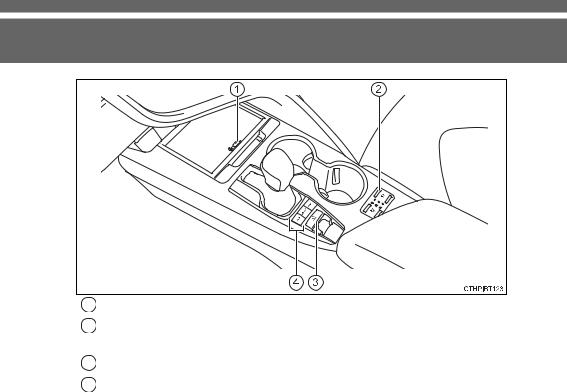
1 Wireless charger switch* . . . . . . . . . . . . . . . . . . . . . . . . . . . P. 394
2 Seat heater switches*. . . . . . . . . . . . . . . . . . . . . . . . . . . . . . P. 377
Seat ventilator switches* . . . . . . . . . . . . . . . . . . . . . . . . . . . P. 377 3 Brake hold switch* . . . . . . . . . . . . . . . . . . . . . . . . . . . . . . . . P. 224 4 Driving mode select switches*. . . . . . . . . . . . . . . . . . . . . . . P. 351
*: If equipped
CAMRY_U
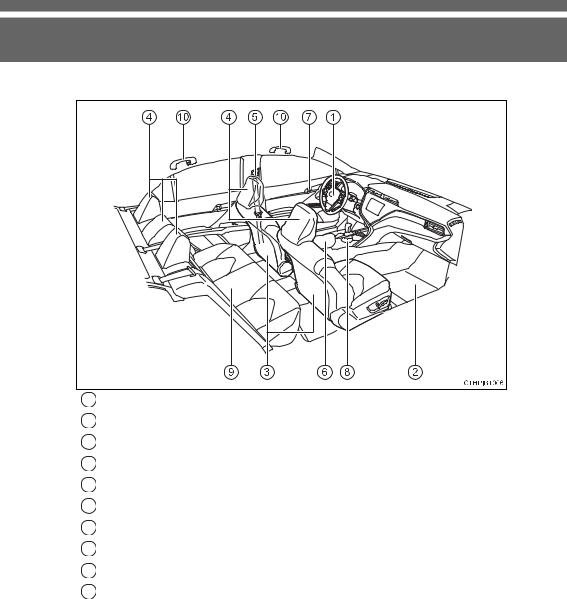
■Interior
1 SRS airbags . . . . . . . . . . . . . . . . . . . . . . . . . . . . . . . . . . . . . . . P. 34 2 Floor mats . . . . . . . . . . . . . . . . . . . . . . . . . . . . . . . . . . . . . . . . P. 24 3 Front seats . . . . . . . . . . . . . . . . . . . . . . . . . . . . . . . . . . . . . . . P. 163 4 Head restraints. . . . . . . . . . . . . . . . . . . . . . . . . . . . . . . . . . . . P. 167 5 Seat belts . . . . . . . . . . . . . . . . . . . . . . . . . . . . . . . . . . . . . . . . . P. 28 6 Console box . . . . . . . . . . . . . . . . . . . . . . . . . . . . . . . . . . . . . . P. 384 7 Inside lock buttons . . . . . . . . . . . . . . . . . . . . . . . . . . . . . . . . P. 145 8 Cup holders . . . . . . . . . . . . . . . . . . . . . . . . . . . . . . . . . . . . . . P. 386 9 Rear seats. . . . . . . . . . . . . . . . . . . . . . . . . . . . . . . . . . . . . . . . P. 165 10 Assist grips . . . . . . . . . . . . . . . . . . . . . . . . . . . . . . . . . . . . . . P. 403
CAMRY_U
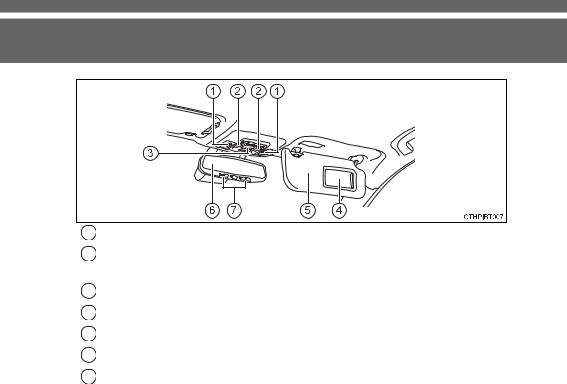
1 Interior lights/personal lights*1 . . . . . . . . . . . . . . . . . . . . . . P. 379
2 Moon roof switches*2 . . . . . . . . . . . . . . . . . . . . . . . . . . . . . . P. 179
Panoramic moon roof switches*2 . . . . . . . . . . . . . . . . . . . . P. 183 3 “SOS” button*2 . . . . . . . . . . . . . . . . . . . . . . . . . . . . . . . . . . . . P. 73 4 Vanity mirrors. . . . . . . . . . . . . . . . . . . . . . . . . . . . . . . . . . . . . P. 390 5 Sun visors . . . . . . . . . . . . . . . . . . . . . . . . . . . . . . . . . . . . . . . P. 390 6 Inside rear view mirror . . . . . . . . . . . . . . . . . . . . . . . . . . . . . P. 171 7 Garage door opener switches*2. . . . . . . . . . . . . . . . . . . . . . P. 405
*1: The illustration shows the front, but they may also be equipped in the rear. *2: If equipped
CAMRY_U

23
|
For safety and security |
1 |
|||
|
1-1. For safe use |
||||
|
Before driving…………………. |
24 |
|||
|
For safe driving ………………. |
26 |
|||
|
Seat belts………………………. |
28 |
|||
|
SRS airbags…………………… |
34 |
|||
|
Front passenger occupant |
||||
|
classification system ……… |
47 |
|||
|
Exhaust gas precautions….. |
52 |
|||
|
1-2. |
Child safety |
|||
|
Riding with children…………. |
53 |
|||
|
Child restraint systems…….. |
54 |
|||
|
1-3. |
Emergency assistance |
|||
|
Safety Connect ………………. |
73 |
|||
|
1-4. Theft deterrent system |
||||
|
Engine immobilizer |
||||
|
system ………………………… |
79 |
|||
|
Alarm…………………………….. |
82 |
CAMRY_U

Before driving

Use only floor mats designed specifically for vehicles of the same model and model year as your vehicle. Fix them securely in place onto the carpet.
1Insert the retaining hooks (clips) into the floor mat eyelets.
2Turn the upper knob of each retaining hook (clip) to secure
|
the floor mats in place. |
* |
|
|
*: Always align the |
marks. |
The shape of the retaining hooks (clips) may differ from that shown in the illustration.
CAMRY_U


Observe the following precautions.
Failure to do so may cause the driver’s floor mat to slip, possibly interfering with the pedals while driving. An unexpectedly high speed may result or it may become difficult to stop the vehicle. This could lead to an accident, resulting in death or serious injury.
■When installing the driver’s floor mat
●Do not use floor mats designed for other models or different model year vehicles, even if they are Toyota Genuine floor mats.
●Only use floor mats designed for the driver’s seat.
●Always install the floor mat securely using the retaining hooks (clips) provided.
●Do not use two or more floor mats on top of each other.
●Do not place the floor mat bottom-side up or upside-down.
■Before driving
●Check that the floor mat is securely 
provided retaining hooks (clips). Be 
after cleaning the floor.
●With the engine stopped and the shift 
the floor to make sure it does not inter- 
1 Forsafety andsecurity
CAMRY_U

For safe driving
For safe driving, adjust the seat and mirror to an appropriate position before driving.

1 Adjust the angle of the seatback so that you are sitting straight up and so that you do not have to lean forward to steer. ( P. 163)
2 Adjust the seat so that you can depress the pedals fully and so that your arms bend slightly at the elbow when gripping the steering wheel. ( P. 163)
3Lock the head restraint in place with the center of the head restraint closest to the top of your ears. ( P. 167)
4Wear the seat belt correctly. ( P. 28)

Make sure that all occupants are wearing their seat belts before driving the vehicle. ( P. 28)
Use a child restraint system appropriate for the child until the child becomes large enough to properly wear the vehicle’s seat belt.
( P. 54)
CAMRY_U


Make sure that you can see backward clearly by adjusting the inside and outside rear view mirrors properly. ( P. 171, 173)

Observe the following precautions.
Failure to do so may result in death or serious injury.
●Do not adjust the position of the driver’s seat while driving. Doing so could cause the driver to lose control of the vehicle.
●Do not place a cushion between the driver or passenger and the seatback. A cushion may prevent correct posture from being achieved, and reduce the effectiveness of the seat belt and head restraint.
●Do not place anything under the front seats.
Objects placed under the front seats may become jammed in the seat tracks and stop the seat from locking in place. This may lead to an accident and the adjustment mechanism may also be damaged.
●Always observe the legal speed limit when driving on public roads.
●When driving over long distances, take regular breaks before you start to feel tired.
Also, if you feel tired or sleepy while driving, do not force yourself to continue driving and take a break immediately.
1 Forsafety andsecurity
CAMRY_U
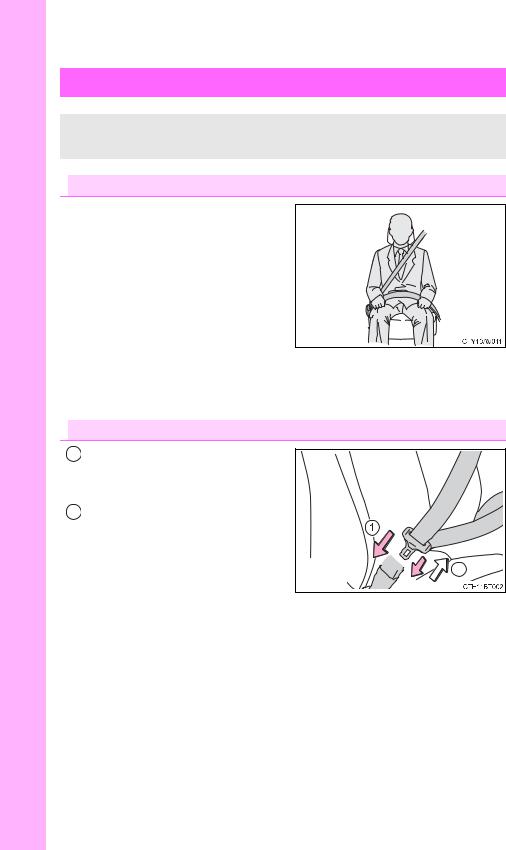
Seat belts
Make sure that all occupants are wearing their seat belts before driving the vehicle.

● Extend the shoulder belt so that it comes fully over the shoulder, but does not come into contact with the neck or slide off the shoulder.
● Position the lap belt as low as possible over the hips.
● Adjust the position of the seatback. Sit up straight and well back in the seat.
● Do not twist the seat belt.

1To fasten the seat belt, push the plate into the buckle until a click sound is heard.
2To release the seat belt, press
the release button.
Release
CAMRY_U
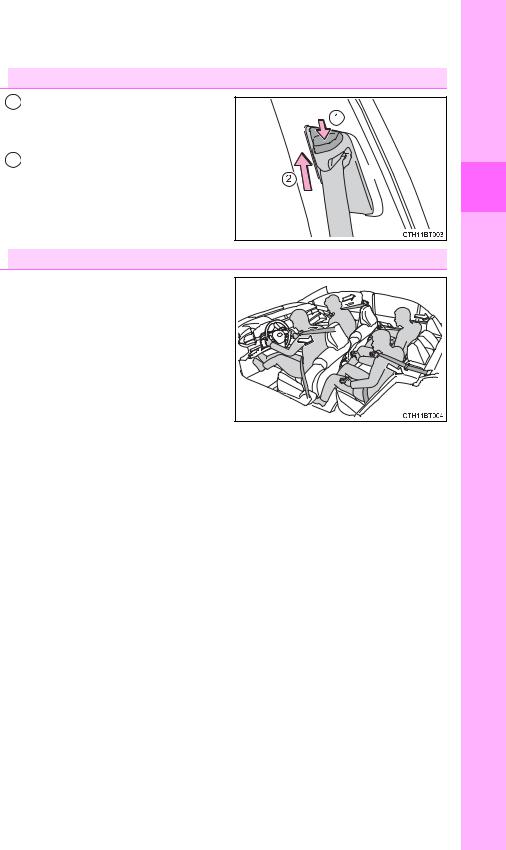

1 Push the seat belt shoulder anchor down while pressing the release button.
2 Push the seat belt shoulder anchor up.
Move the height adjuster up and down as needed until you hear a 

The pretensioners help the seat belts to quickly restrain the occupants by retracting the seat belts when the vehicle is subjected to certain types of severe frontal or side collision or a vehicle rollover.
The pretensioners do not activate in the event of a minor frontal impact, a minor side impact or a rear impact.
1 Forsafety andsecurity
CAMRY_U
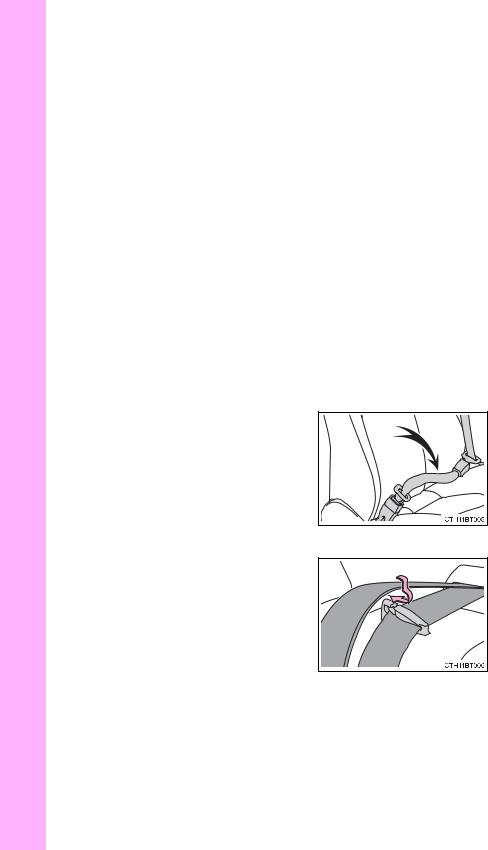
■Emergency locking retractor (ELR)
The retractor will lock the belt during a sudden stop or on impact. It may also lock if you lean forward too quickly. A slow, easy motion will allow the belt to extend so that you can move around fully.
■Automatic locking retractor (ALR)
When a passenger’s shoulder belt is completely extended and then retracted even slightly, the belt is locked in that position and cannot be extended. This feature is used to hold the child restraint system (CRS) firmly. To free the belt again, fully retract the belt and then pull the belt out once more. ( P. 56)
■Child seat belt usage
The seat belts of your vehicle were principally designed for persons of adult size.
●Use a child restraint system appropriate for the child, until the child becomes large enough to properly wear the vehicle’s seat belt. ( P. 54)
●When the child becomes large enough to properly wear the vehicle’s seat belt, follow the instructions regarding seat belt usage. ( P. 28)
■Replacing the belt after the pretensioner has been activated
If the vehicle is involved in multiple collisions, the pretensioner will activate for the first collision, but will not activate for the second or subsequent collisions.
■Seat belt extender
If your seat belts cannot be fastened securely because they are not long enough, a personalized seat belt extender is available from your Toyota dealer free of charge.
■Rear seat belt
Use the seat belt after passing it through the guide if the seat belt comes free from the guide.
CAMRY_U


Observe the following precautions to reduce the risk of injury in the event of sudden braking, sudden swerving or an accident.
Failure to do so may cause death or serious injury.
■Wearing a seat belt
●Ensure that all passengers wear a seat belt.
●Always wear a seat belt properly.
●Each seat belt should be used by one person only. Do not use a seat belt for more than one person at once, including children.
●Toyota recommends that children be seated in the rear seat and always use a seat belt and/or an appropriate child restraint system.
●To achieve a proper seating position, do not recline the seat more than necessary. The seat belt is most effective when the occupants are sitting up straight and well back in the seats.
●Do not wear the shoulder belt under your arm.
●Always wear your seat belt low and snug across your hips.
■Pregnant women
Obtain medical advice and wear the seat
belt in the proper way. ( P. 28) 



completely over the shoulder and avoid- 
abdominal area. 




■People suffering illness
Obtain medical advice and wear the seat belt in the proper way. ( P. 28)
1 Forsafety andsecurity
CAMRY_U


■When children are in the vehicle
P. 66
■Seat belt pretensioners
●Do not place anything, such as a cushion, on the front passenger’s seat. Doing so will disperse the passenger’s weight, which prevents the sensor from detecting the passenger’s weight properly. As a result, the seat belt pretensioner for the front passenger’s seat may not activate in the event of a collision.
●If the pretensioner has activated, the SRS warning light will come on. In that case, the seat belt cannot be used again and must be replaced at your Toyota dealer.
■Adjustable shoulder anchor
Always make sure the shoulder belt is positioned across the center of your shoulder. The belt should be kept away from your neck, but not falling off your shoulder. Failure to do so could reduce the amount of protection in an accident and cause death or serious injuries in the event of a sudden stop, sudden swerve or accident. ( P. 29)
■Seat belt damage and wear
●Do not damage the seat belts by allowing the belt, plate, or buckle to be jammed in the door.
●Inspect the seat belt system periodically. Check for cuts, fraying, and loose parts. Do not use a damaged seat belt until it is replaced. Damaged seat belts cannot protect an occupant from death or serious injury.
●Ensure that the belt and plate are locked and the belt is not twisted.
If the seat belt does not function correctly, immediately contact your Toyota dealer.
●Replace the seat assembly, including the belts, if your vehicle has been involved in a serious accident, even if there is no obvious damage.
●Do not attempt to install, remove, modify, disassemble or dispose of the seat belts. Have any necessary repairs carried out by your Toyota dealer. Inappropriate handling may lead to incorrect operation.
●Always make sure the shoulder belt passes through the guide when using the seat belt. Failure to properly position the belt may reduce the amount of protection in an accident and could lead to death or serious injury in a collision or sudden stop.
●Always make sure that the seat belt is not twisted, does not get caught in the guide or the seatback and is arranged in the proper position.
CAMRY_U


■Using a seat belt extender
●Do not wear the seat belt extender if you can fasten the seat belt without the extender.
●Do not use the seat belt extender when installing a child restraint system
because the belt will not securely hold the child restraint system, increasing the risk of death or serious injury in the event of an accident.
●The personalized extender may not be safe on another vehicle, when used by another person, or at a different seating position other than the one originally intended.

■When using a seat belt extender
When releasing the seat belt, press on the buckle release button on the extender, not on the seat belt.
This helps prevent damage to the vehicle interior and the extender itself.
1 Forsafety andsecurity
CAMRY_U

SRS airbags
The SRS airbags inflate when the vehicle is subjected to certain types of severe impacts that may cause significant injury to the occupants. They work together with the seat belts to help reduce the risk of death or serious injury.
SRS front airbags
1SRS driver airbag/front passenger airbag
Can help protect the head and chest of the driver and front passenger from impact with interior components
2SRS knee airbags
Can help provide driver and front passenger protection
CAMRY_U

SRS side and curtain shield airbags
3 SRS front side airbags
Can help protect the torso of the front seat occupants
4 SRS rear side airbags
Can help protect the torso of occupants in the rear outer seats 5 SRS curtain shield airbags
● Can help protect primarily the head of occupants in the outer seats
● Can help prevent the occupants from being thrown from the vehicle in the event of vehicle rollover
1 Forsafety andsecurity
CAMRY_U


1Front impact sensors
2Front passenger occupant classification system (ECU and sensors)
3Knee airbags
4Side impact sensors (front doors)
5Side impact sensors (front)
6Front passenger airbag
7Front side airbags
8Curtain shield airbags
9Rear side airbags
10 “AIRBAG ON” and “AIRBAG
OFF” indicator lights
11SRS warning light
12Front passenger’s seat belt buckle switch
13Airbag sensor assembly
14Side impact sensors (rear)
15Driver airbag
16Driver’s seat belt buckle switch
17Seat belt pretensioners and force limiters
18Driver’s seat position sensor
Your vehicle is equipped with ADVANCED AIRBAGS designed based on the US motor vehicle safety standards (FMVSS208). The airbag sensor assembly (ECU) controls airbag deployment based on information obtained from the sensors etc. shown in the system components diagram above. This information includes crash severity and occupant information. As the airbags deploy, a chemical reaction in the inflators quickly fills the airbags with non-toxic gas to help restrain the motion of the occupants.
CAMRY_U


■SRS airbag precautions
Observe the following precautions regarding the SRS airbags. Failure to do so may cause death or serious injury.
●The driver and all passengers in the vehicle must wear their seat belts properly.
The SRS airbags are supplemental devices to be used with the seat belts.
●The SRS driver airbag deploys with considerable force, and can cause death or serious injury especially if the driver is very close to the airbag. The National Highway Traffic Safety Administration (NHTSA) advises:
Since the risk zone for the driver’s airbag is the first 2 — 3 in. (50 — 75 mm) of inflation, placing yourself 10 in. (250 mm) from your driver airbag provides you with a clear margin of safety. This distance is measured from the center of the steering wheel to your breastbone. If you sit less than 10 in. (250 mm) away now, you can change your driving position in several ways:
•Move your seat to the rear as far as you can while still reaching the pedals comfortably.
•Slightly recline the back of the seat.
Although vehicle designs vary, many drivers can achieve the 10 in. (250
mm)distance, even with the driver seat all the way forward, simply by reclining the back of the seat somewhat. If reclining the back of your seat makes it hard to see the road, raise yourself by using a firm, nonslippery cushion, or raise the seat if your vehicle has that feature.
•If your steering wheel is adjustable, tilt it downward. This points the airbag toward your chest instead of your head and neck.
The seat should be adjusted as recommended by NHTSA above, while still maintaining control of the foot pedals, steering wheel, and your view of the instrument panel controls.
1 Forsafety andsecurity
CAMRY_U


■SRS airbag precautions
●If the seat belt extender has been connected to the front seat belt buckles but the seat belt extender has not also been fastened to the latch plate of the seat belt, the SRS front airbags will judge that the driver and front passenger are wearing the seat belt even though the seat belt has not been connected. In this case, the SRS front airbags may not activate correctly in a collision, resulting in death or serious injury in the event of a collision. Be sure to wear the seat belt with the seat belt extender.
●The SRS front passenger airbag also deploys with considerable force, and can cause death or serious injury especially if the front passenger is very close to the airbag. The front passenger seat should be as far from the airbag as possible with the seatback adjusted, so the front passenger sits upright.
●Improperly seated and/or restrained infants and children can be killed or seriously injured by a deploying airbag. An infant or child who is too small to use a seat belt should be properly secured using a child restraint system. Toyota strongly recommends that all infants and children be placed in the rear seats of the vehicle and properly restrained. The rear seats are safer for infants and children than the front passenger seat. ( P. 54)
CAMRY_U


■SRS airbag precautions
●Do not sit on the edge of the seat or lean against the dashboard.
●Do not allow a child to stand in front of the SRS front passenger airbag unit or sit on the knees of a front passenger.
●Do not allow the front seat occupants to hold items on their knees.
●Do not lean against the door, the roof side rail or the front, side and rear pillars.
●Do not allow anyone to kneel on the passenger seats toward the door or put their head or hands outside the vehicle.
CAMRY_U


■SRS airbag precautions
●Do not attach anything to or lean anything against areas such as the dashboard, steering wheel pad and lower portion of the instrument panel.
These items can become projectiles when the SRS driver, front passenger and knee airbags deploy.
●Do not attach anything to areas such as a door, windshield, windows, front or rear pillar, roof side rail and assist grip.
●Vehicles without a smart key system: Do not attach any heavy, sharp or hard objects such as keys and accessories to the key. The objects may restrict the SRS knee airbag inflation or be thrust into the driver’s seat area by the force of the deploying airbag, thus causing a danger.
●Do not hang coat hangers or other hard objects on the coat hooks. All of these items could become projectiles and may cause death or serious injury, should the SRS curtain shield airbags deploy.
CAMRY_U


■SRS airbag precautions
●If a vinyl cover is put on the area where the SRS knee airbag will deploy, be sure to remove it.
●Do not use seat accessories which cover the parts where the SRS side
airbags inflate as they may interfere with inflation of the airbags. Such accessories may prevent the side airbags from activating correctly, disable the system or cause the side airbags to inflate accidentally, resulting in death or serious injury.
●Do not strike or apply significant levels of force to the area of the SRS airbag components or the front doors.
Doing so can cause the SRS airbags to malfunction.
●Do not touch any of the component parts immediately after the SRS airbags have deployed (inflated) as they may be hot.
●If breathing becomes difficult after the SRS airbags have deployed, open a door or window to allow fresh air in, or leave the vehicle if it is safe to do so. Wash off any residue as soon as possible to prevent skin irritation.
●If the areas where the SRS airbags are stored, such as the steering wheel pad and front and rear pillar garnishes, are damaged or cracked, have them replaced by your Toyota dealer.
●Do not place anything, such as a cushion, on the front passenger’s seat. Doing so will disperse the passenger’s weight, which prevents the sensor from detecting the passenger’s weight properly. As a result, the SRS front airbags for the front passenger may not deploy in the event of a collision.
1 Forsafety andsecurity
CAMRY_U


■Modification and disposal of SRS airbag system components
Do not dispose of your vehicle or perform any of the following modifications without consulting your Toyota dealer. The SRS airbags may malfunction or deploy (inflate) accidentally, causing death or serious injury.
●Installation, removal, disassembly and repair of the SRS airbags
●Repairs, modifications, removal or replacement of the steering wheel, instrument panel, dashboard, seats or seat upholstery, front, side and rear pillars, roof side rails, front door panels, front door trims or front door speakers
●Modifications to the front door panel (such as making a hole in it)
●Repairs or modifications of the front fender, front bumper, or side of the occupant compartment
●Installation of a grille guard (bull bars, kangaroo bar, etc.), snow plows, winches or roof luggage carrier
●Modifications to the vehicle’s suspension system
●Installation of electronic devices such as mobile two-way radios and CD players
●Modifications to your vehicle for a person with a physical disability
■If the SRS airbags deploy (inflate)
●Slight abrasions, burns, bruising etc., may be sustained from SRS airbags, due to the extremely high speed deployment (inflation) by hot gases.
●A loud noise and white powder will be emitted.
●Parts of the airbag module (steering wheel hub, airbag cover and inflator) as well as the front seats, parts of the front and rear pillars, and roof side rails, may be hot for several minutes. The airbag itself may also be hot.
●The windshield may crack.
●All of the doors will be unlocked. ( P. 148)
●The brakes and stop lights will be controlled automatically. ( P. 302)
●The interior lights will turn on automatically. ( P. 382)
●The emergency flashers will turn on automatically. ( P. 486)
●Fuel supply to the engine will be stopped. ( P. 494)
CAMRY_U

●For Safety Connect subscribers, if any of the following situations occur, the system is designed to send an emergency call to the response center, notifying them of the vehicle’s location (without needing to push the “SOS” button) and an agent will attempt to speak with the occupants to ascertain the level of emergency and assistance required. If the occupants are unable to communicate, the agent automatically treats the call as an emergency and helps to dispatch the necessary emergency services. ( P. 73)
• An SRS airbag is deployed.
•A seat belt pretensioner is activated.
•The vehicle is involved in a severe rearend collision.
■SRS airbag deployment conditions (SRS front airbags)
●The SRS front airbags will deploy in the event of an impact that exceeds the set threshold level (the level of force corresponding to an approximately 12 — 18 mph [20 — 30 km/h] frontal collision with a fixed wall that does not move or deform).
However, this threshold velocity will be considerably higher in the following situations:
•If the vehicle strikes an object, such as a parked vehicle or sign pole, which can move or deform on impact
•If the vehicle is involved in an underride collision, such as a collision in which the front of the vehicle “underrides”, or goes under, the bed of a truck
●Depending on the type of collision, it is possible that only the seat belt pretensioners will activate.
●The SRS front airbags for the front passenger will not activate if there is no passenger sitting in the front passenger seat. However, the SRS front airbags for the front passenger may deploy if luggage is put in the seat, even if the seat is unoccupied.
■SRS airbag deployment conditions (SRS side and curtain shield airbags)
●The SRS side and curtain shield airbags will deploy in the event of an impact that exceeds the set threshold level (the level of force corresponding to the impact force produced by an approximately 3300 lb. [1500 kg] vehicle colliding with the vehicle cabin from a direction perpendicular to the vehicle orientation at an approximate speed of 12 — 18 mph [20 — 30 km/h]).
●Both SRS curtain shield airbags may deploy in the event of a severe side collision.
●Both SRS curtain shield airbags will deploy in the event of vehicle rollover.
●Both SRS curtain shield airbags may also deploy in the event of a severe frontal collision.
1 Forsafety andsecurity
CAMRY_U

■Conditions under which the SRS airbags may deploy (inflate), other than a collision
The SRS front airbags and SRS curtain shield airbags may also deploy if a serious impact occurs to the underside of your vehicle.
Some examples are shown in the illustration.
●Hitting a curb, edge of pavement or hard surface
●Falling into or jumping over a deep hole ●Landing hard or falling
The SRS curtain shield airbags may also deploy under the situations shown in the illustration.
●The angle of vehicle tip-up is marginal.
●The vehicle skids and hits a curb stone.
■Types of collisions that may not deploy the SRS airbags (SRS front airbags)
The SRS front airbags do not generally inflate if the vehicle is involved in a side or rear collision, if it rolls over, or if it is involved in a low-speed frontal collision. But, whenever a collision of any type causes sufficient forward deceleration of the vehicle, deployment of the SRS front airbags may occur.
●Collision from the side
●Collision from the rear ●Vehicle rollover
CAMRY_U

■Types of collisions that may not deploy the SRS airbags (SRS side and curtain shield airbags)
The SRS side and curtain shield airbags may not activate if the vehicle is subjected to a collision from the side at certain angles, or a collision to the side of the vehicle body other than the passenger compartment.
●Collision from the side to the vehicle body other than the passenger compart-
ment
●Collision from the side at an angle
The SRS side airbags do not generally inflate if the vehicle is involved in a frontal or rear collision, if it rolls over, or if it is involved in a low-speed side collision.
●Collision from the front
●Collision from the rear ●Vehicle rollover
The SRS curtain shield airbags do not generally inflate if the vehicle is involved in a rear collision, if it pitches end over end, or if it is involved in a low-speed side or low-speed frontal collision.
●Collision from the rear ●Pitching end over end
1 Forsafety andsecurity
CAMRY_U

■When to contact your Toyota dealer
In the following cases, the vehicle will require inspection and/or repair. Contact your Toyota dealer as soon as possible.
●Any of the SRS airbags have been inflated.
●The front of the vehicle is damaged or
deformed, or was involved in an accident that was not severe enough to cause the SRS front airbags to inflate.
●A portion of a door or its surrounding area is damaged, deformed or has had a hole made in it, or the vehicle was involved in an accident that was not severe enough to cause the SRS side and curtain shield airbags to inflate.
●The pad section of the steering wheel, dashboard near the front passenger airbag or lower portion of the instrument panel is scratched, cracked, or otherwise damaged.
●The surface of the seats with the SRS side airbag is scratched, cracked, or otherwise damaged.
●The portion of the front pillars, rear pillars or roof side rail garnishes (padding) containing the SRS curtain shield airbags inside is scratched, cracked, or otherwise damaged.
CAMRY_U

Front passenger occupant classification system
Your vehicle is equipped with a front passenger occupant classification system. This system detects the conditions of the front passenger seat and activates or deactivates the front passenger 1 airbag and front passenger knee airbag.
|
U.S.A. |
Canada |
security and safety For |
||
|
Type A |
Type B |
Type A |
Type B |
1Driver’s and front passenger’s seat belt reminder light
2SRS warning light
3“AIRBAG OFF” indicator light
4“AIRBAG ON” indicator light
CAMRY_U

Condition and operation in the front passenger occupant classification system
■ Adult*1
|
“AIRBAG ON” and “AIRBAG OFF” |
“AIRBAG ON” |
||
|
indicator lights |
|||
|
Indicator/ |
|||
|
SRS warning light |
Off |
||
|
warning light |
|||
|
Driver’s and front passenger’s seat belt |
Off*2 or |
||
|
reminder light |
flashing*3 |
||
|
Devices |
Front passenger airbag |
Activated |
|
|
Front passenger knee airbag |
|||
|
■ Child*4 |
|||
|
“AIRBAG ON” and “AIRBAG OFF” |
“AIRBAG |
||
|
OFF” or |
|||
|
indicator lights |
|||
|
Indicator/ |
“AIRBAG ON”*4 |
||
|
warning light |
SRS warning light |
Off |
|
|
Driver’s and front passenger’s seat belt |
Off*2 or |
||
|
reminder light |
flashing*3 |
||
|
Devices |
Front passenger airbag |
Deactivated or |
|
|
activated*4 |
|||
|
Front passenger knee airbag |
|||
|
■ Child restraint system with infant*5 |
|||
|
“AIRBAG ON” and “AIRBAG OFF” |
“AIRBAG |
||
|
Indicator/ |
indicator lights |
OFF”*6 |
|
|
SRS warning light |
Off |
||
|
warning light |
|||
|
Driver’s and front passenger’s seat belt |
Off*2 or |
||
|
reminder light |
flashing*3 |
||
|
Devices |
Front passenger airbag |
Deactivated |
|
|
Front passenger knee airbag |
|||
CAMRY_U

■ Unoccupied
|
“AIRBAG ON” and “AIRBAG OFF” |
“AIRBAG |
||
|
Indicator/ |
indicator lights |
OFF” |
|
|
SRS warning light |
|||
|
warning light |
|||
|
Off |
|||
|
Driver’s and front passenger’s seat belt |
|||
|
reminder light |
|||
|
Devices |
Front passenger airbag |
Deactivated |
|
|
Front passenger knee airbag |
|||
|
■ There is a malfunction in the system |
|||
|
“AIRBAG ON” and “AIRBAG OFF” |
“AIRBAG OFF” |
||
|
indicator lights |
|||
|
Indicator/ |
|||
|
SRS warning light |
|||
|
warning light |
|||
|
On |
|||
|
Driver’s and front passenger’s seat belt |
|||
|
reminder light |
|||
|
Devices |
Front passenger airbag |
Deactivated |
|
|
Front passenger knee airbag |
|||
*1: The system judges a person of adult size as an adult. When a smaller adult sits in the front passenger seat, the system may not recognize him/her as an adult depending on his/her physique and posture.
*2: In the event the front passenger is wearing a seat belt. *3: In the event the front passenger does not wear a seat belt.
*4: For some children, child in seat, child in booster seat or child in convertible seat, the system may not recognize him/her as a child. Factors which may affect this can be the physique or posture.
*5: Never install a rear-facing child restraint system on the front passenger seat. A forward-facing child restraint system should only be installed on the front passenger seat when it is unavoidable. ( P. 54)
*6: In case the indicator light is not illuminated, consult this manual on how to install the child restraint system properly. ( P. 56)
1 Forsafety andsecurity
CAMRY_U


■Front passenger occupant classification system precautions
Observe the following precautions regarding the front passenger occupant classification system.
Failure to do so may cause death or serious injury.
●Wear the seat belt properly.
●Make sure the front passenger’s seat belt plate has not been left inserted into the buckle before someone sits in the front passenger seat.
●Make sure the “AIRBAG OFF” indicator light is not illuminated when using the seat belt extender for the front passenger seat. If the “AIRBAG OFF” indicator light is illuminated, disconnect the extender tongue from the seat belt buckle, and reconnect the seat belt. Reconnect the seat belt extender after making sure the “AIRBAG ON” indicator light is illuminated. If you use the seat belt extender while the “AIRBAG OFF” indicator light is illuminated, the SRS airbags for the front passenger will not activate, which could cause death or serious injury in the event of a collision.
●Do not apply a heavy load to the front passenger seat or equipment (e.g. seatback pocket).
●Do not put weight on the front passenger seat by putting your hands or feet on the front passenger seat seatback from the rear passenger seat.
●Do not let a rear passenger lift the front passenger seat with their feet or press on the seatback with their legs.
●Do not put objects under the front passenger seat.
CAMRY_U


